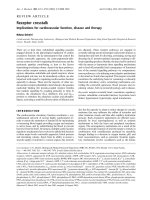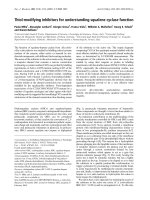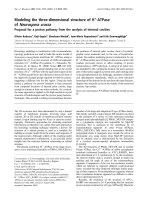Báo cáo y học: "Electrical muscle stimulation for prevention of critical illness polyneuropathy" pdf
Bạn đang xem bản rút gọn của tài liệu. Xem và tải ngay bản đầy đủ của tài liệu tại đây (108.76 KB, 2 trang )
We read with interest the study by Routsi and colleagues
showing that electrical muscle stimulation (EMS)
reduced the frequency of critical illness polyneuropathy
in intensive care unit (ICU) patients [1] . e authors
stated that an intention-to-treat analysis was used. One
hundred and forty patients were randomized to electrical
stimulation or to usual care. Measurement of the main
outcome could only be performed in cooperating patients
surviv ing after awakening. us, 39 patients (57%) and 44
patients (61%) who died or who had impaired cognitive
state were excluded from analysis in each arm. Data from
fi ve out of 29 subjects on the intervention arm were also
excluded from the fi nal analysis because of neuro muscu lar
blocker use (n = 3) or a lack of electrical stimulation
during the ICU stay (n = 2). e latter probably induced a
selection bias, as subjects receiving neuromuscular
blockers have increased risk of critical illness polyneuro-
pathy and patients with this condition have not been
excluded from the usual care group [2] . e authors
reported other outcomes such as duration of mechanical
ventilation or ICU length of stay for patients with strength
score evaluation, while analysis in all randomized subjects
could have been valuable.
Finally, reported strength scores represented the
addition of upper and lower extremities, while stimu-
lation was only applied to the latter. As systemic eff ects of
EMS have not been defi nitely established in this setting,
it would have been interesting to compare the strength of
muscles where the intervention was tested.
© 2010 BioMed Central Ltd
Electrical muscle stimulation for prevention of
critical illness polyneuropathy
Pablo O Rodriguez*
1,2
, Mariano Setten
1,3
and Ricardo Valentini
1,2
See related research by Routsi et al., />LETTER
*Correspondence:
1
Intensive Care Unit, CEMIC (Centro de Educación Médica e Investigaciones
Clínicas), Av. Las Heras 2900, C1425ASS Buenos Aires, Argentina
Full list of author information is available at the end of the article
Authors’ response
Sera m Nanas
We thank Dr Rodriguez and colleagues for their interest
in our study [1]. We agree that some selection bias could
exist because we excluded patients receiving neuro-
muscular blocking agents in the EMS group but not in
the control group. is was not, however, the case in our
study. Among the patients that could be fi nally evaluated
for critical illness poly neuromyopathy (n = 52), only one
patient – assigned to the control group – received
prolonged neuromuscular blockade agents. As this
patient was not diagnosed with critical illness
polyneuromyopathy (Medical Research Council score
52), this case could not aff ect our results.
Secondly, the duration of mechanical ventilation, the
duration of weaning and the ICU length of stay are
reported in all patients that were randomized regardless
of whether they could be evaluated with the Medical
Research Council scale for muscle strength.
Finally, in a previous study by our group [3] we showed
that EMS of lower extremities has an acute systemic eff ect
on the microcirculation of critically ill patients. More over,
the data of our recent study [1] – showing a shorter
duration of weaning in patients assigned to the EMS group –
indicate a long-term systemic eff ect of EMS. e eff ect of
EMS of lower extremities on the muscle strength of upper
extremities is relevant, but this was not the scope of the
study. We agree, however, that this is of interest and
deserves to be examined in a further study.
Abbreviations
EMS, electrical muscle stimulation; ICU, intensive care unit.
Author details
1
Intensive Care Unit, CEMIC (Centro de Educación Médica e Investigaciones
Clínicas), Av. Las Heras 2900, C1425ASS Buenos Aires, Argentina.
2
Instituto
Universitario CEMIC, Galvan 4102, C1431FWO Buenos Aires, Argentina.
3
Department of Physiotherapy, CEMIC, Av. Las Heras 2900, C1425ASS Buenos
Aires, Argentina.
Rodriguez et al. Critical Care 2010, 14:428
/>© 2010 BioMed Central Ltd
Competing interests
The authors declare they have no competing interests.
Published: 12 July 2010
References
1. Routsi C, Gerovasili V, Vasileiadis I, Karatzanos E, Pitsolis T, Tripodaki ES, Markaki
V, Zervakis D, Nanas S: Electrical muscle stimulation prevents critical illness
polyneuromyopathy: a randomized parallel intervention trial. Crit Care
2010, 14:R74.
2. Garnacho-Montero J, Madrazo-Osuna J, Garcia-Garmendia JL, Ortiz-Leyba C,
Jimenez-Jimenez FJ, Barrero-Almodovar A, Garnacho-Montero MC,
Moyano-Del-Estad MR: Critical illness polyneuropathy: risk factors and
clinical consequences. A cohort study in septic patients. Intensive Care Med
2001, 27:1288-1296.
3. Gerovasili V, Tripodaki E, Karatzanos E, Pitsolis T, Markaki V, Zervakis D, Routsi
C, Roussos C, Nanas S: Short-term systemic e ect of electrical muscle
stimulation in critically ill patients. Chest 2009, 136:1249-1256.
doi:10.1186/cc9081
Cite this article as: Rodriguez PO, et al.: Electrical muscle stimulation for
prevention of critical illness polyneuropathy. Critical Care 2010, 14:428.
Rodriguez et al. Critical Care 2010, 14:428
/>Page 2 of 2









